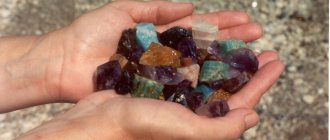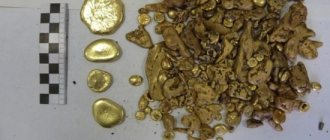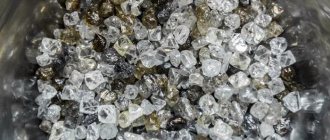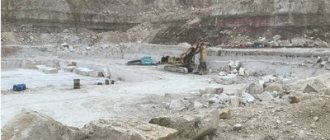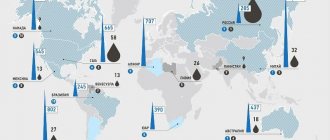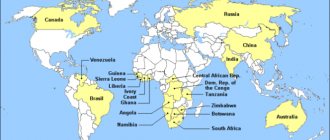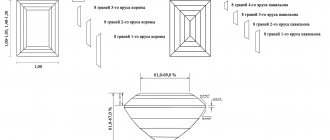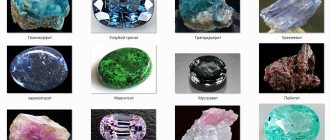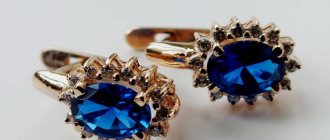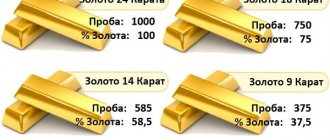Marketers came up with the iconic slogan “Diamonds are Forever” for De Beers more than a hundred years ago. Agree, this is a brilliant move: two words made diamonds in people’s minds a symbol of wealth and eternal love. And at the same time, they provided confidence for diamond mining companies in their own future.
De Beers, by the way, still maintains its reputation as a major diamond producer. However, in terms of volume and value of diamonds mined in the world, it is in second place. The leader of this very specific market is the Russian Alrosa.
This market is unusual. Judge for yourself: the main influence here is exerted by the five largest companies; in total they mine three quarters of the world's diamonds - the cost of entering the market is very high. Artel companies, of course, are difficult to count, but they certainly cannot reach the heights of the Big Five.
“The diamond market can be compared to the platinum group metals market, where just a few companies dominate. There are also similarities between diamonds and PGMs in the geographical location of the deposits - Russia and African countries are at the top. But the diamond market is relatively small - in monetary terms it is 10 times smaller than the PGM market and 100 times smaller than the gold market.
The demand for natural diamonds is not so great that a larger number of deposits could operate profitably,” explained Mikhail Dyagilev, Chairman of the Committee for Supporting Entrepreneurship in the Field of Mining, Production, Processing and Circulation of Precious Metals and Precious Stones of the RF Chamber of Commerce and Industry, General Director of Krastsvetmet OJSC.
Diamond Geography
The bulk of world diamond production (about 97%) is provided by the already mentioned Russia, the countries of South Africa, Canada and Australia.
“In 2019, global diamond production amounted to 141 million carats. These are not peak values, but the indicators are quite high,” noted the chief geologist of AK Alrosa, Konstantin Garanin, speaking at the webinar “Geology and mineral resource base of diamonds in Siberia and the Arctic regions of Russia.”
The online conference “Geology and mineral resource base of diamonds in Siberia and the Arctic regions of Russia” was held as part of the media educational project “Geowebinar”, which began its work in April of this year. At its origins were the Society of Russian Experts on Subsoil Use, the Faculty of Geology of Moscow State University and the international mining and geological forum Mingeo Siberia and the online investment platform “Territory of Resources”. Currently, the project regularly hosts online conferences, lectures and seminars for mining industry professionals.
Our country is the undisputed leader in diamond mining, although only two players represent Russia. A player, to put it mildly, unequal. About 42 million carats are mined in Russia every year, 5 million of which come from AGD Diamonds, the rest of the volume is mined by the global diamond giant Alrosa.
It is noteworthy that the map of diamond resources is not identical to the map of their production. Regions such as West Africa, Asia, and the USA are emerging as promising.
“It seems that the geography is wider - but this is only on one side. On the other hand, in recent decades it has not been possible to bring new fields into development. Although there have been attempts to work in the northern regions of Australia, as well as in Brazil. As a result, the main diamond mining is still concentrated in the leading countries,” commented Mr. Garanin.
In general, with regard to the volume of global diamond resources, the figures given in various sources differ significantly, including because the methodology for estimating resources differs. The consolidated estimate of experts is about 5 billion carats.
And here Russia is ahead of the rest: according to JORC, we have 1162.5 million carats of resource reserves - this is 22% of the world. A very promising diamond country is Botswana (19%), however, there is still active mining going on here. 12% comes from Angola and 8% from South Africa, which makes the African continent an incredibly attractive region for miners. The Americas contain 11.5% of the world's resources, of which 10% are in Canada.
Mikhail Dyagilev, Chairman of the Committee for Supporting Entrepreneurship in the Field of Mining, Production, Processing and Circulation of Precious Metals and Precious Stones of the Russian Chamber of Commerce and Industry, General Director of OJSC Krastsvetmet
“What do precious metals and stones have in common? Firstly, we have a common law. Secondly, the general regulator is the Ministry of Finance. If we talk about the scale of the industry, diamond mining accounts for approximately 1/7 of the consolidated precious metals and gemstones industry.
According to my estimate, the annual turnover of diamonds in Russia reaches 300 billion rubles, and the entire turnover of precious metals and stones reaches 2 trillion rubles. Of this, about 1.5 trillion rubles is the turnover of gold. I now mean all mined and produced precious metals, including secondary production, which entered the foreign and domestic markets and constitute the revenue of companies operating in the industry. But if in our country there are two companies involved in diamonds, then there are more than 550 in precious metals.
Almost all of them mine gold, and only a few companies are involved in platinum metals. Diamonds are very similar to gold in their meaning and significance for people: they are used in the production of jewelry, in addition, they are an investment item. After all, gold is also mainly a non-industrial metal. 85% of gold is sent to the investment sphere or for jewelry purposes, and is stored in the form of banking products.”
Available methods of mining gems
The methods of mining semi-precious stones have remained almost the same as in ancient times. They dig a mine with the help of shovels, lifting rocks in baskets on ropes. Usually work begins next to a river in which rocks can be washed. During the washing process, workers find 1-2 gems per basket of rock. After this, the process is repeated from the beginning. Finders sell their finds at auctions or local markets. Specialists process them and deliver them to stores.
Gems without impurities are valued on the market. Only a specialist can determine this. He carries out preliminary processing and cutting of minerals. For example, sapphires are heated to impart a beautiful hue. The master must know the properties of stones in order to distinguish a piece of jewelry from a fake.
Production in Sri Lanka
In Sri Lanka, stone mining is done by hand. Of the automatic means, only pumps are used that pump out groundwater. The mines are dug right in the rice fields. Excavators and other equipment are not used, as they leave behind lakes and swamps.
Sri Lanka is known for the fact that the entire island contains a huge amount of minerals. Half of the known types of stones used for jewelry are found here. Development is carried out by private seekers under a special license, which must be paid annually.
Primitive mining methods
The easiest way to develop precious stones is to collect placers along mountain rivers. Crystal growths are on the surface and can be seen in rock crevices. They are knocked down with a hammer and chisel; in some cases, jackhammers and explosives are used. Explosives are rarely used because they can damage valuable minerals.
Another method is mining at the mouth of the river. It is specially accelerated so that the water flows faster. The workers stand in the water and muddy the bottom with long poles. Light sandy components are carried away by the water, and semi-precious stones remain at the bottom.
The most difficult way to obtain gems is to build deep mines. They are dug using special equipment, and ceilings are built so that the walls do not crumble. The entrance is covered with a shelter from the rain. Groundwater is pumped out with pumps. Natural stones lie in a sandy layer, and mining is carried out in it. Horizontal workings occupy several meters underground.
Mined Gems
Use of explosives
Mountain adits are built in hard rock using explosives. This method is time-consuming and labor-intensive, so it is used only if there is confidence in the deposits of precious stones. Typically, gem mining is combined with geological exploration and mining of other minerals.
The main problem of all mines and mines is theft. They not only bring losses to prospectors and mining companies, but also reduce the price of gems on the market. Therefore, serious companies carefully guard their mines.
Gemstone mining takes place in rock formations, estuaries and open ground. In some countries, independent mining is prohibited; only industrial enterprises can do this. Other countries allow such fishing upon purchase of a license.
"Witnesses of the Kimberlite Pipe"
However, perhaps today we do not know everything about our home planet. Konstantin Garanin once again confirmed: almost all diamond deposits known today are associated with kimberlites, which are confined to the Archonian - with an Archean basement and a cratonization age of 2500 million years or more.
The second priority is protons. The Australian Argyle field is certainly an interesting phenomenon. This is a very rich site, but it is still the only lamproite pipe in the world where diamonds are mined on an industrial scale. True, Mr. Garanin noted that in the coming years it will be fully developed.
“There is a lot of discussion about identifying additional sources of rough diamonds, but until now such work has not been carried out on an industrial scale. However, we all know about the Popigai crater, and Victor Masaitis once determined that the resources of such a structure can exceed in weight the resources of all diamonds, which are concentrated in all diamond-bearing bodies of other kinetic structures in the world.
In our company, the level of subsurface knowledge is very high, and our analysts focus on kimberlite deposits. However, we are waiting for discoveries from our scientific colleagues to substantiate the industrial diamond potential of other types of mineral raw materials,” said Konstantin Garanin.
Deputy Head of Center-Sibnedra Ivan Kurbatov believes that such active interest in kimberlite structures - especially in Russia - has not only a geological, but also a historical basis.
It's no secret that most modern mineral deposits, including precious metals and stones, were discovered by Soviet geologists in the middle of the last century. They discovered - in the sense they put it on the map, the development of many of them began much later, and some have not yet begun at all.
The Union began searching for diamonds immediately after the war, the work went on a wide front, factories and aircraft sites appeared in the once uninhabited taiga, and the search itself turned into some kind of production competition.
“1949 was a milestone year. Firstly, this is the year of the discovery of Yakut diamonds. Well, secondly, it was in April of this year that big changes began in the USSR Ministry of Geology, which ricocheted through the diamond miners. The Minister of Geology changed, and this event brought a lot of confusion to the organization of work. I would call the introduction of strict secrecy the biggest negative innovation,” says Ivan Kurbatov.
Geological organizations, says Ivan Ivanovich, were transferred almost to martial law - with security, seals and a regime of secrecy. But geology is a science where much is built on analogies, and if geologists do not exchange information, they can easily miss something important.
Ivan Kurbatov told how in the 1980s he came across a brochure about unconventional types of diamond-bearing lamproite rocks in Australia. It was marked “For official use only.”
“So many geologists simply did not have this knowledge. As a result, in the geological environment, among those who dealt with diamonds, a “caste of witnesses to the kimberlite pipe” was formed, possessing some sacred knowledge. I believe that this state of affairs had a negative impact on the effectiveness of the work, primarily in those regions where diamond ore bodies and pipes were not found,” says Ivan Kurbatov.
A little about the history of stone mining in Russia
For a long time it was believed that there were no precious stones in Russia. Jewelers worked with imported gems and local pearls, which were found in the rivers of the North. Russian minerals began to be mined in the mid-17th century, when deposits of malachite, rock crystal, amethyst and topaz were discovered in the Urals.
Mineral deposits in the Urals
However, for a long time the stones were mined in small quantities. Local residents dug mines on their own to discover valuable specimens. The discovered gems were processed by self-taught craftsmen and sent to the capital. However, large-scale development began in the 18th century, when Peter I became interested in underground wealth.
For a long time, the main attention was paid to the development of malachite deposits. In the 19th century, the Russian Empire completely filled the domestic market with this mineral and exported it abroad in large quantities.
Malachite living room of the Winter Palace in St. Petersburg
Malachite was used for making jewelry, handicrafts, finishing buildings, and producing copper. This stone was used to decorate rooms in the Winter Palace in St. Petersburg. Due to the fact that the mining of malachite was not controlled and the mineral was exported in large quantities, the rich deposits have now almost dried up.
The first diamonds were found in the Urals by accident in July 1829. A serf peasant discovered a 1.5-carat crystal while panning for gold in the Perm province. Over the next 100 years, 250 specimens were found, the average weight of which was 25 carats. However, Russia became one of the largest suppliers of diamonds in the mid-20th century after the discovery of kimberlite pipes in Yakutia.
In search of diamonds
But, as follows from the above figures, nature has not deprived our country, and even the hypothetical underexploration of the subsoil does not prevent us from being leaders in world diamond mining.
And of course, you shouldn’t think that modern diamond makers are only eating away at the Soviet legacy. Reproduction of SMEs remains an urgent task for our miners - and at the same time a problem for the industry.
If we talk about Alrosa, then it is not just a very large, but also a fairly diversified industrial group: in addition to its production and sales structures, the company has its own gas assets and transport capacities, including an aircraft fleet. Of course, Alrosa pays a lot of attention to geological exploration.
“The main task of the geological exploration complex is to ensure an increase in reserves and predicted resources of category P1. This is probably why any exploration enterprise exists. A special feature is the powerful conduct of appraisal work, and the company allocates a significant part of the geological exploration budget to increase the predicted resources P2 and P3,” noted Konstantin Garanin.
The company's interests in Russia are now concentrated in three regions. The richest territory is the Siberian platform, in particular, the Republic of Sakha: Mr. Garanin spoke about 900 million carats of local reserves. Work is also being carried out in the Arkhangelsk region and in the Perm region.
“Yes, we all remember that the first Russian diamond was found precisely on the territory of what is now the Perm Territory, but today the placers here have been mined, and the prospect of mining the primary deposits has not yet been realized. Therefore, from the point of view of the exploration potential, our presence in two main regions is logical: in Yakutia and in the Arkhangelsk region,” said the chief geologist of Alrosa.
Alrosa is definitely not in danger of depleting its deposits in the coming years. And yet, Mikhail Diaghilev says that geological exploration issues are a problematic issue for the industry.
Yes, Alrosa is investing heavily in geological exploration, but it is most actively working on already discovered and most promising deposits - which, in fact, is natural. Nothing like the large-scale state geological exploration expeditions of the 1950s that Ivan Kurbatov spoke about simply does not exist today.
“The reduction in the scale of government funding for geological exploration work with insufficient incentives for businesses to carry it out entails a reduction in the volume of geological exploration work at the early stages and a decrease in the number of promising fields being discovered.
Large mining companies in Russia invest in late-stage geological exploration, but a support system for small and medium-sized companies carrying out early-stage geological exploration has not been formed.
Among the issues of geological study and exploration work, it is worth noting the need for measures to stimulate business: removing restrictions on the number of licenses obtained on an application basis; abolition of fees for converting an exploration license into a production license; inclusion of participants with forecast resources P1 and P2 in the mechanism for obtaining licenses on an application basis; raising the threshold for strategic deposits to 200 tons; introduction of mechanisms for tax compensation of costs for exploration activities before the start of resource extraction, and others,” Mikhail Dyagilev listed possible steps to change the situation.
The problem of subsoil waste, which we talked about a lot when describing the work of gold mining enterprises, is also relevant for diamond miners. With diamonds, it’s exactly the same story: mining companies call waste mining a process that is not economically viable.
However, what is today called waste is more correctly called one of the types of SMEs. But to use it, additional conditions are needed.
“It is necessary to provide the opportunity to extract minerals and components from subsoil waste without conducting a geological study of the subsoil, within the boundaries of the allotment granted in accordance with the license; without conducting a state examination of mineral reserves; without coordination and approval of technical designs and other project documentation for the performance of work related to the use of subsoil.
Mineral reserves in subsoil areas provided for the extraction of minerals from subsoil use waste are proposed to be put on operational accounting based on the results of their development and written off upon completion of the work.
It is necessary to set the period of use of subsoil for the extraction of minerals from subsoil waste to 20 years. There are quite a lot of proposals, and their implementation, I hope, will allow subsoil users to begin profitable extraction of minerals from subsoil waste,” said Mikhail Dyagilev.
LiveInternetLiveInternet
CHAROITE IS A UNIQUE STONE THAT HAS THE ONLY DEPOSIT IN THE WORLD. Charoite is a native Russian stone. The only deposit of charoite in the world is located at the junction of Yakutia and the Irkutsk region, in the area of the Baikal-Amur Mainline, in the valley of the Chara River. For the first time, blocks with purple minerals were found by geologist V.G. Ditmar in 1948, during a geological survey, and tentatively called them cumingtonite shale. The deposit itself was found in 1960. In the early 1970s, a comprehensive study of the deposit began. The deposit discovered by Soviet geologists is unique: not only have no commercial deposits of such rocks been found in the world, but deposits containing single grains of charoite have also not been discovered.
Charoite deposit Lilac Stone. The world's only charoite deposit, Lilac Stone, is located on an area of just over ten square kilometers on the border of the Irkutsk Region and the Republic of Sakha. Stone mining is carried out only at one site, Stary, located at the very top of the Ditmarovsky stream. However, in some other areas you can find good examples of this wonderful ornamental stone.
Quarry of the Sirenevy Kamen deposit, Stary section View of the bedrock outcrops of charoite rock in the walls of the mine workings of the Stary quarry of the Sirenevy Kamen deposit, Irkutsk region.
The origin of charoite rocks is largely unclear. They are associated with carbonatite alkaline melts and are possibly formed as a result of metasomatic replacement of the host strata. Other researchers suggest the igneous origin of the deposit.
Lenticular body of charoite rock, Novy area
In the mine workings of the New section of the Sirenevy Kamen deposit, you can see bodies of charoite rock of various shapes.
High quality charoite
Blocks of high grade charoite at the New site of the Sirenevy Kamen deposit.
Block of high-quality charoite at the Novy site, Sirenevy Kamen deposit
Large block of high-quality charoite, Novy site, Lilac Stone deposit.
There is a remarkable story associated with the discovery of charoite. The discoverer of the deposit, Yuri Gavrilovich Rogov, was sent by the government on a business trip abroad. There he went to the Louvre Mineralogical Museum, which claimed to have a complete collection of all the minerals of the Earth and, showing a plate of lilac rock, asked to identify the mineral. The museum staff were forced to admit that they did not have such a mineral, and offered to buy a sample. But the Soviet geologist refused.
Pope John Paul II had previously purchased a slab of beautiful violet-lilac charoite for his sarcophagus.
HEALING PROPERTIES OF CHAROITE. Charoite, due to its color, has a sedative effect on the nervous system. The violet color itself has a healing effect, having a calming effect on the human psyche - prolonged contemplation of the stone relaxes, treats nervous diseases, brings peace and peace of mind. Wearing charoite as a talisman increases immunity and activates the body's defenses, relieves mental stress and excitement accumulated during the day, improves memory - it is especially useful for those who spend most of their time in front of a computer monitor. Faceted charoite is placed on the suffering part of the body so that it “draws out” pain and tension - it has an excellent effect on the liver, kidneys, pancreas, and heart muscle. In addition, charoite relieves chronic diseases - normalizes blood pressure, helps with prostatitis and diseases of the genitourinary system. It cleanses the endocrine glands, helps destroy kidney stones and sclerotic plaques. Charoite is also useful for bone diseases - lumbago, lumbago, curvature of the spine, fractures. In some countries, traditional healers used this stone to relieve headaches, and charoite beads were placed on the head to improve the condition of a patient with a concussion. Charoite bracelets are recommended to be worn by people with various types of mental illness. It is believed that pendants and pendants help with neuralgia. Some lithostrapists suggest that charoite can be used to improve the functioning of the heart, digestive organs, urinary and gall bladders. Perhaps polished charoite dies relieve inflammatory processes. However, it should be remembered that prolonged exposure to this stone on the body can lead to a depressed state of the nervous system. Charoite affects the crown, throat and heart chakras.
MAGICAL PROPERTIES OF CHAROITE. Since charoite was discovered relatively recently, its magical properties have not yet been sufficiently studied. The mystical properties of charoite are also symbolically associated with the color violet, which in all centuries has symbolized spirituality, wisdom and harmony. Charoite is the stone of philosophers, those who lead a calm and measured lifestyle. It increases prudence and protects the soul of its owner from “energy dirt.” Charoite helps you see the true picture of the world and feel unity with all that exists. Like amethyst, it promotes restraint, calmness and endurance, teaches you to strictly measure spoken words, develops the spirit, and awakens intuition. At the same time, charoite is a stone of charm and love harmony. This is the keeper of the family hearth - if there is a charoite figurine in your house, then love and mutual understanding will never leave it. It is believed that the owner of charoite jewelry will never be left alone. Charoite helps to withstand any situation, to realize self-realization in artistic creativity - this is a wonderful amulet for people of art. He also helps those who do charity work. Zodiacally, Charoite corresponds to the planet Venus and the sign Libra.
TALISMANS AND AMULETS. Charoite is a talisman of philosophers and poets. You can use a ring with this stone as a talisman. This talisman is able to teach its owner to deeply sense the world around him and communicate with higher spiritual forces. The talisman can also be made in the form of a ball, which should be placed on a silver stand and kept on the desktop. In this case, inspiration will be a frequent visitor to the owner of the talisman. Modern practicing magicians use charoite stone to make amulets that feed their owner with cosmic energy.
Charoite stone is not very durable, it should be protected from impacts. Products made from charoite can be washed in warm water.
https://www.inmoment.ru/magic/healing/charoit.html
"Alrosa" and all, all, all
By the way, Russia has not always been a diamond-mining power. At the beginning of the 20th century, De Beers occupied about 80% of the world market, but by the end of the century, the USSR, Canada and Australia ousted the company that was at the origins of diamond mining from its monopoly pedestal. However, even today Alrosa calls De Beers its main competitor.
World diamond reserves today are estimated at 1,774 million carats. 35% of them are Alrosa reserves, 24% are De Beers, whose assets are concentrated in Botswana, South Africa, Namibia and Canada.
In third place is Rio Tinto, with assets in Australia and Canada. The company's Australian field is the famous Argyle. When it is worked out, only two large companies will dominate the market.
Photo: alrosa.ru
Among them are Petra Diamonds and Dominion Diamond. In general, smaller enterprises compared to the market giants have anchor assets, and if all these shares are consolidated, they will amount to up to 30% of all global diamond production.
Two clarifications are important here. Firstly, Russian diamonds are not only Alrosa. The second player in our market, AGD Diamonds, is a fairly large company, but its achievements are simply “lost” against the backdrop of the diamond giant. In general, this is one of the oldest companies in the European north of Russia for the search, exploration, extraction and processing of minerals.
Various types of minerals - not just diamonds. However, it was the development of the diamond deposit named after. The company today calls V. Grib its main task. According to various estimates, the deposit's reserves are about 100 million carats with an annual production of 5 million carats.
True, as Konstantin Garanin said, the project was subject to adjustments, and at the moment, according to Alrosa’s estimates, the reserves of the deposit named after. V. Grib have decreased significantly and amount to only 50–60 million carats.
Well, secondly, Alrosa is not only about Russian diamonds: the company is a co-owner of the powerful Katoka deposit, where the Russian miner owns 41%.
“I am pleased to say that we are diversifying our business and entering the African continent. We have been working in Angola for 20 years now, have assessed the prospects of Botswana, and are now starting geological exploration work in Zimbabwe.
Each region where there are facts of discovery of diamond reserves is interesting for the company; we have been carrying out assessment and analytical work for a long time, and in different departments, so that the possible potential of entering a particular project is realized,” said Konstantin Garanin.
Green stone
In ancient times, emeralds - green precious stones - were endowed with magical powers. Different cultures attributed magical properties to emeralds: granting the ability to see the past and future, strengthening families, protecting against insomnia, snakes, and much more. The Greeks called emerald smaragdos, “shining stone.” The emerald ring was worn by A.S. Pushkin, considering him his talisman.
If we talk about the modern value of emerald, today it is equal to diamonds, sapphires, rubies and other first-class gems. Emeralds have been used in jewelry since ancient times; today the stone is also used in the creation of solid-state lasers. Emerald is a type of the mineral beryl, which in its pure form is colorless and has a glassy luster. A less valuable relative of emerald is considered to be aquamarine, which has a delicate shade of sea water. Beryllium, isolated from beryllium ores, is used in the defense, nuclear and aerospace industries.
The quality of an emerald is determined by its color and clarity. Bright green, transparent stones with rich color can be more expensive than diamonds. In addition, the price is affected by the size of the emerald, since small stones are much more common.
Emerald mines of the Urals
Deposits of green stone are scattered almost all over the world. At the same time, emeralds from different mines differ, and the birthplace of the stone can be determined by its characteristics. The largest deposits of emeralds are found in South America and Africa, where about half of all stones in the world are mined. The largest emerald, “Theodora,” weighing 11.5 kg, was found in Brazil. Also, Afghan emeralds with clean and dense crystals are highly valued by specialists.
The main emerald-beryllium deposits not only in Russia, but throughout Europe are concentrated in the Urals. The richest emerald veins here were discovered in the 1830s, when peasants began to find precious stones on their plots. In 1834, the commander of the Yekaterinburg lapidary factory, Yakov Vasilyevich Kokovin, founded the Mariinsky mine here, named in honor of St. Mary of Egypt and which became part of the emerald mine complex of the Urals.
The Mariinskaya vein turned out to be very rich in green stones. Initially, they were only mined at the mine, and processing was carried out in other places. Thus, in the first 10 years, 5 thousand carats of Mariinsky emeralds were cut in Peterhof. In 1899, the mine was leased by an Anglo-French company, which organized the processing of stones on site.
In 1919, the Mariinsky mine was nationalized by the Bolsheviks. In the year of the 10th anniversary of the October Revolution, the mine is named after the Ural revolutionary I.M. Malysheva. In the 1930s, new mines and an emerald extraction factory were built at the mine. During industrialization, the mining of precious stones faded into the background - the growing industry needed beryllium concentrate, obtained from the mineral beryl, and beryllium alloy for high-speed aircraft cannons and machine guns. Beryllium, mined at the Malyshevsky mine, was used as a neutron moderator in the structural elements of the first Soviet atomic bomb and the first reactor of a nuclear power plant.
History of the Mariinsky mine
From 1952 to 1994, the Malyshevskoe Mining Administration, a city-forming enterprise in the village named after Malyshev in the Sverdlovsk Region, which is part of the First Main Directorate of the USSR Ministry of Medium Machine Building, operated at the mine. After the collapse of the Soviet Union, the company experienced difficult times. In 1996-2007, the field was exploited by the Canadian company Tsar Emerald International, which during this time was unable to fulfill its obligations and revive the enterprise. In 2008, the mine became part of the Rostec State Corporation. Since that time, emerald mining has been gradually restored, the emerald extraction factory has been relaunched, and in 2018 the company returned to its historical name - the Mariinsky mine.
